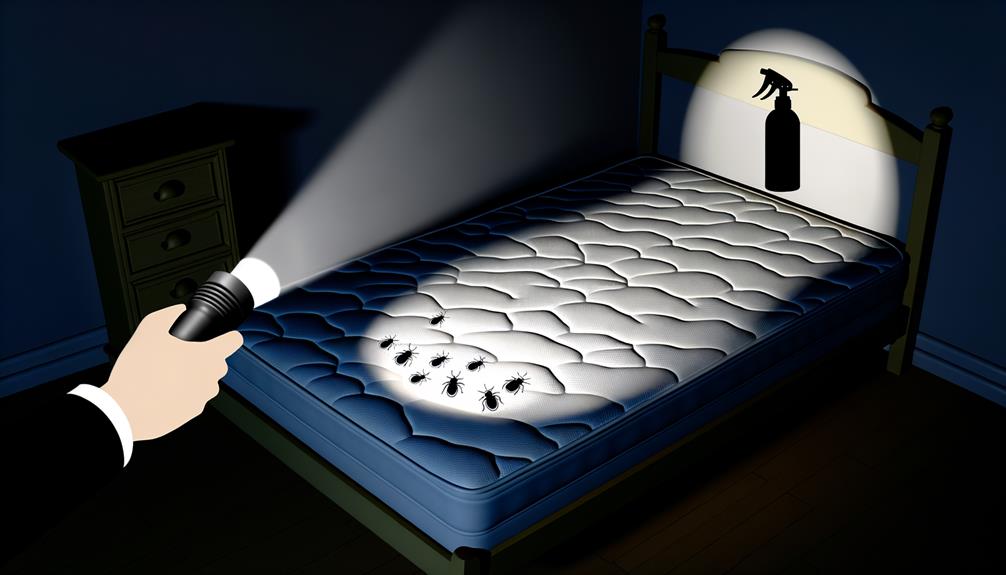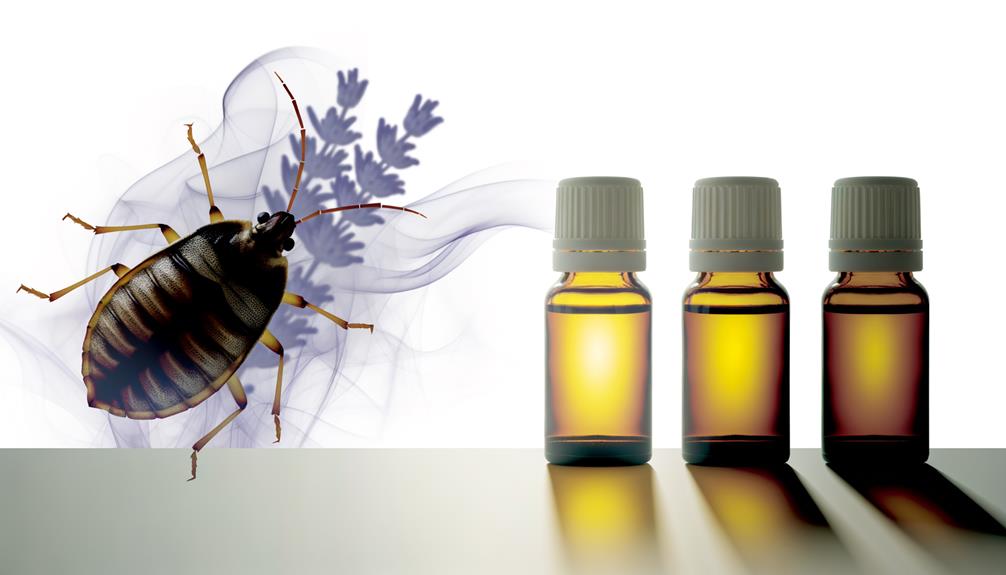Are you waking up to itchy bites and wondering what you can spray on your mattress to combat bed bugs? There’s a range of options from over-the-counter insecticides to natural essential oil solutions that you might consider. However, it’s crucial to choose a method that’s safe for both you and your sleeping environment. Before you make a decision, let’s explore the effectiveness and safety of these treatments. This could be the first step towards reclaiming your peace of mind and a good night’s sleep. Curious about which option best suits your situation? Let’s dive deeper into the possibilities.
Key Takeaways
- Use over-the-counter insecticides specifically labelled for bed bugs, following instructions carefully.
- Essential oils like lavender can be sprayed for a natural repellent option.
- Applying a thin layer of food-grade diatomaceous earth on the mattress can dehydrate and kill bed bugs.
- For severe infestations, professional exterminators can provide tailored heat treatments to eliminate bed bugs from mattresses.
Identifying Bed Bugs Infestation

To effectively tackle a bed bug infestation, you first need to know the signs that indicate their presence in your environment. Recognizing the early indicators can significantly improve your chances of controlling them promptly. One of the most telling signs of an infestation is the bite symptoms you might experience. Bed bug bites often appear as small, red, itchy welts, typically in a line or cluster on your skin, especially on areas exposed while sleeping. These symptoms can vary from person to person, but their appearance in the morning is a strong indicator of night activity, as bed bugs are predominantly active at night.
Understanding their night activity is crucial. Bed bugs are elusive creatures that hide during the day and come out at night to feed on your blood. You might not catch them in the act, but their nocturnal habits leave behind evidence. Besides bite marks, look for tiny blood spots on your sheets, small dark excrement stains, or even shed skins and eggs around bed frames, mattress seams, and nightstands. Being armed with this knowledge, you’ll feel a sense of belonging among those who’ve successfully identified and combated these pests, steering clear of the distress and discomfort they cause.
Pre-Treatment Preparations
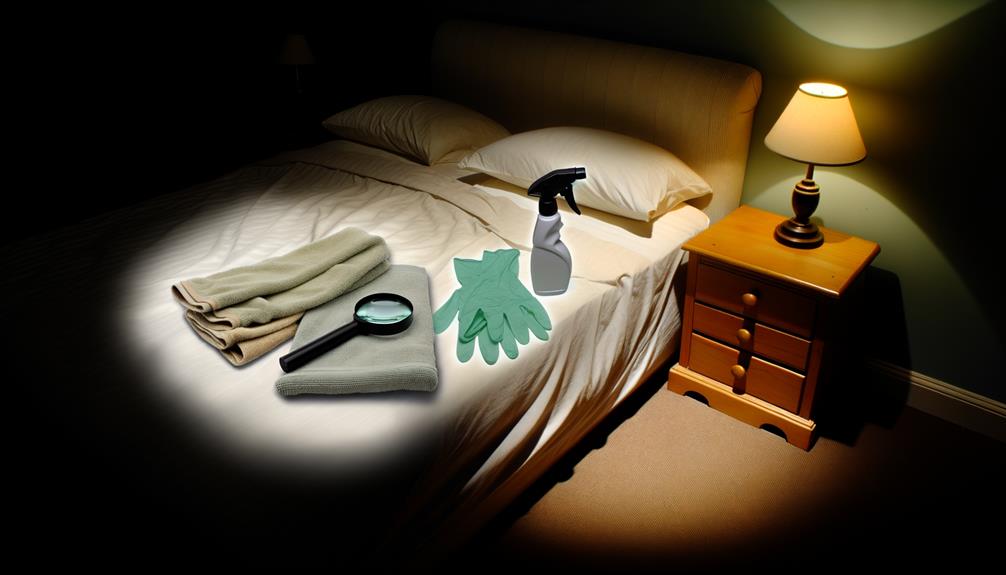
Before applying any spray for bed bugs, you must identify the areas of infestation to target your efforts effectively. You’ll need to engage in thorough cleaning and decluttering, as this reduces hiding spots for bed bugs and improves the efficacy of treatment. These steps form a critical foundation for any successful bed bug eradication strategy.
Identify Infestation Areas
Identifying bed bug infestation areas is a critical first step in any effective treatment plan, allowing you to target your efforts where they’re most needed. Begin by examining your mattress, bed frame, and nearby furniture for signs of bed bugs, such as small brown spots or live insects. Pay close attention to bite symptoms on your body, which can indicate active feeding areas. Implement travel precautions to prevent the spreading or reintroducing of bed bugs, including inspecting luggage and clothing after trips. Understanding the specific locations of infestation within your home empowers you to apply treatments more effectively and monitor progress. This targeted approach not only enhances the effectiveness of bed bug control measures but also fosters a sense of community through shared experiences and solutions.
Cleaning and Decluttering
Having pinpointed bed bug infestation areas in your home, it’s crucial to now focus on cleaning and decluttering as key pre-treatment steps to enhance the effectiveness of subsequent control measures. Organizing closets is your first line of defence. By meticulously sorting through your belongings, you’re eliminating hiding spots for these pests, creating a less hospitable environment for them. Equally essential is vacuuming regularly, especially in corners and beneath furniture, to remove any bed bugs or eggs that may have nestled away. This routine not only maintains cleanliness but also disrupts the life cycle of bed bugs, significantly reducing their numbers. Adopting these practices fosters a sense of belonging in a clean, secure home environment, laying a solid foundation for eradication efforts.
Over-the-Counter Insecticides
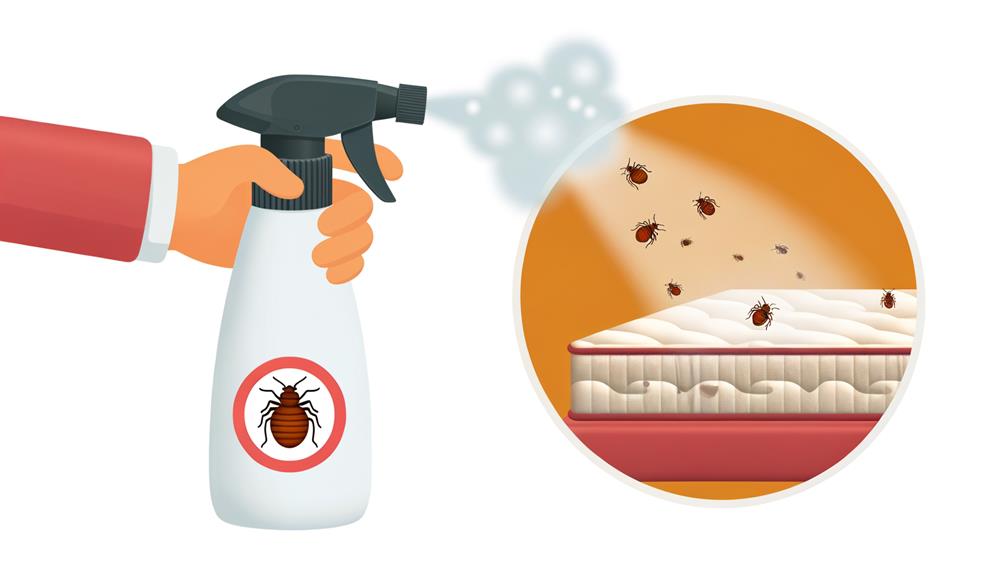
Over-the-counter insecticides offer a readily accessible option for combating bed bug infestations in your home. They’re designed to target these pests efficiently, but it’s crucial to understand how to use them properly to avoid chemical resistance. Bed bugs have shown a remarkable ability to adapt to various pesticides, making it essential to choose products with proven efficacy against them. You’ll find different application methods available, including sprays, powders, and aerosols. Each has its specific use case, with sprays being ideal for direct application on mattresses and other surfaces where bed bugs hide.
When selecting an over-the-counter solution, look for products that specifically mention bed bugs on the label and follow the instructions meticulously. It’s not just about spraying indiscriminately; it’s about targeted, thoughtful application to the areas most affected. Consider the lifecycle of bed bugs, aiming to disrupt it at both the adult and egg stages for a more effective treatment.
Essential Oil Solutions
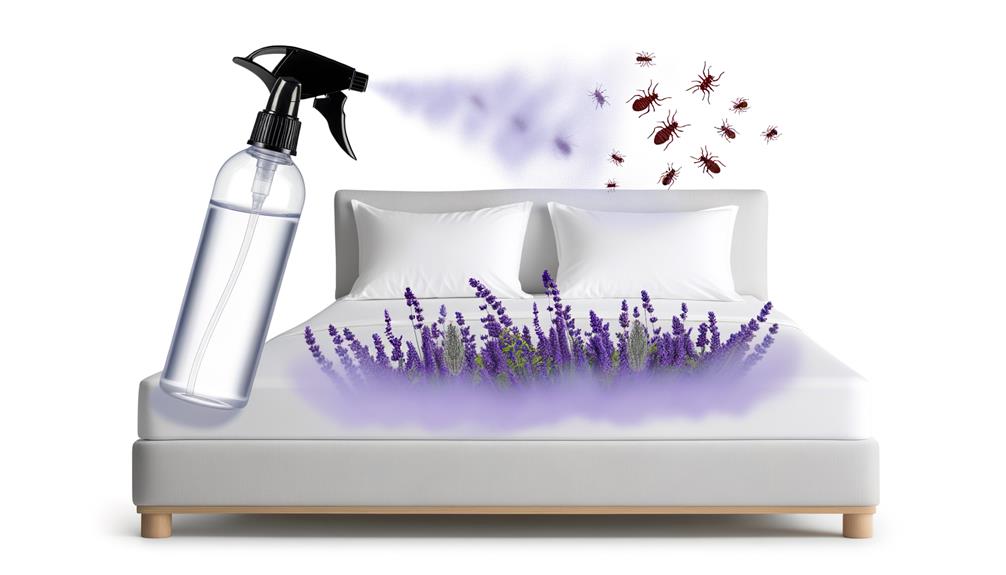
For individuals seeking a natural alternative to chemical insecticides, essential oils have emerged as an effective solution for combating bed bug infestations. These plant-derived oils, when correctly diluted and applied, can offer both a potent deterrent and a method for reducing bed bug populations in your home. You’re not alone in your search for safer pest control methods, and the community of people turning to essential oils is growing.
Understanding oil dilution is critical. Essential oils are potent and must be diluted with a carrier oil or water to ensure safety and efficacy. A common ratio is 10-15 drops of essential oil per ounce of water or carrier oil. This dilution not only protects your skin and fabrics but also ensures the scent effectiveness is optimized for repelling bed bugs.
Lavender, tea tree, and eucalyptus oils are among the most effective against bed bugs due to their strong olfactory-repelling properties. The scent effectiveness of these oils disrupts the bed bugs’ ability to navigate and feed, effectively reducing their numbers over time. By incorporating these essential oil solutions into your pest control strategy, you’re joining a community committed to safer, natural alternatives.
Diatomaceous Earth Application
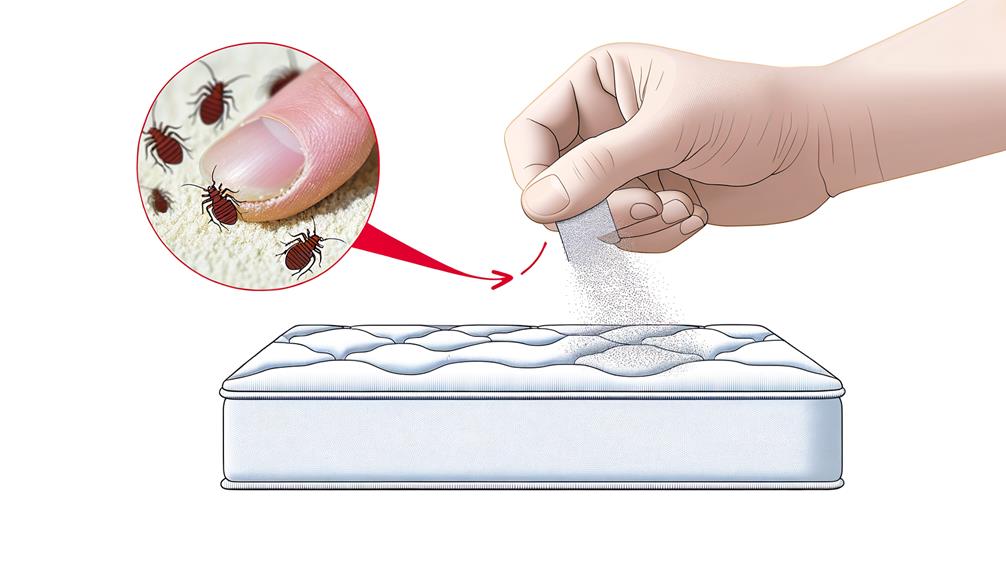
After exploring the efficacy of essential oils, another natural option to consider in your battle against bed bugs is the application of diatomaceous earth. This natural, powdery substance is made from the fossilized remains of tiny, aquatic organisms known as diatoms. Its microscopic, sharp edges cut through the exoskeletons of bed bugs, effectively dehydrating and killing them.
For your safety and the well-being of your household, it’s crucial to choose food-grade diatomaceous earth. This grade ensures that the product is safe for use around humans and pets, maintaining your home’s aquatic safety. When applying diatomaceous earth, wear a mask to avoid inhaling the fine dust, and use a duster to apply a thin, even layer on your mattress, focusing on seams, tufts, and any crevices bed bugs might hide.
Heat Treatment Strategies
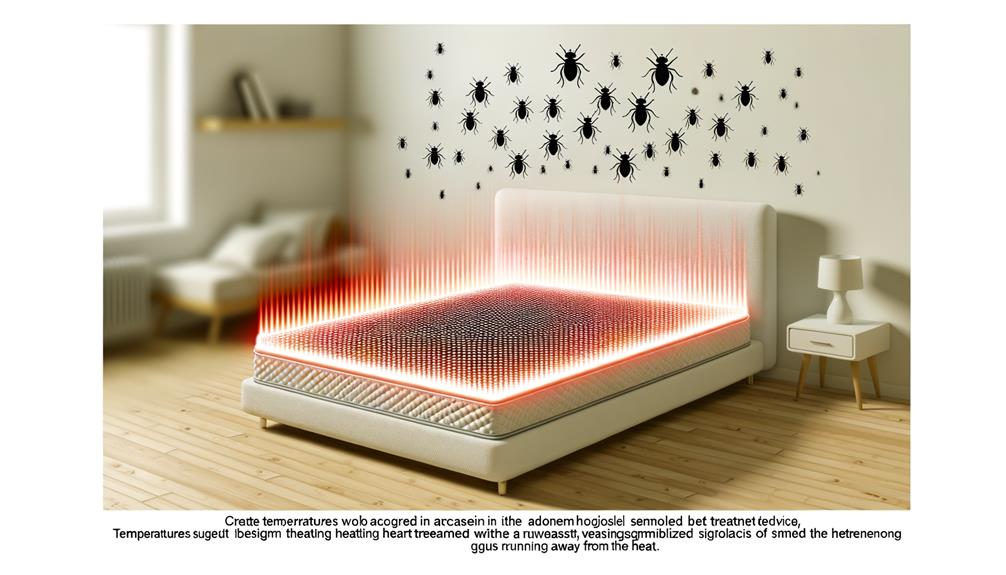
Transitioning from diatomaceous earth, you’ll find heat treatment to be an effective strategy in eradicating bed bugs by exposing them to temperatures they cannot survive. This method leverages the critical insight that bed bugs, at all stages of their life cycle, succumb to high temperatures. Specifically, maintaining an environment at 118°F (47.8°C) for 90 minutes or at 122°F (50°C) for a few minutes ensures their extermination.
Heat treatment works by penetrating potential hideouts, and reaching temperature thresholds that are lethal to bed bugs without damaging your belongings. However, achieving and maintaining these temperatures requires specialized equipment and expertise. This is where professional exterminators come into play. They’re equipped with the tools and knowledge to safely and effectively raise the temperature of your space, ensuring that the heat permeates even the most secluded crevices where bed bugs might hide.
Moreover, engaging professional exterminators means they can tailor the heat treatment to your specific situation, factoring in the layout of your home and the severity of the infestation. This personalized approach not only increases the chance of completely eliminating bed bugs but also provides you with peace of mind, knowing that you’re not alone in dealing with this challenge.
Post-Treatment Considerations
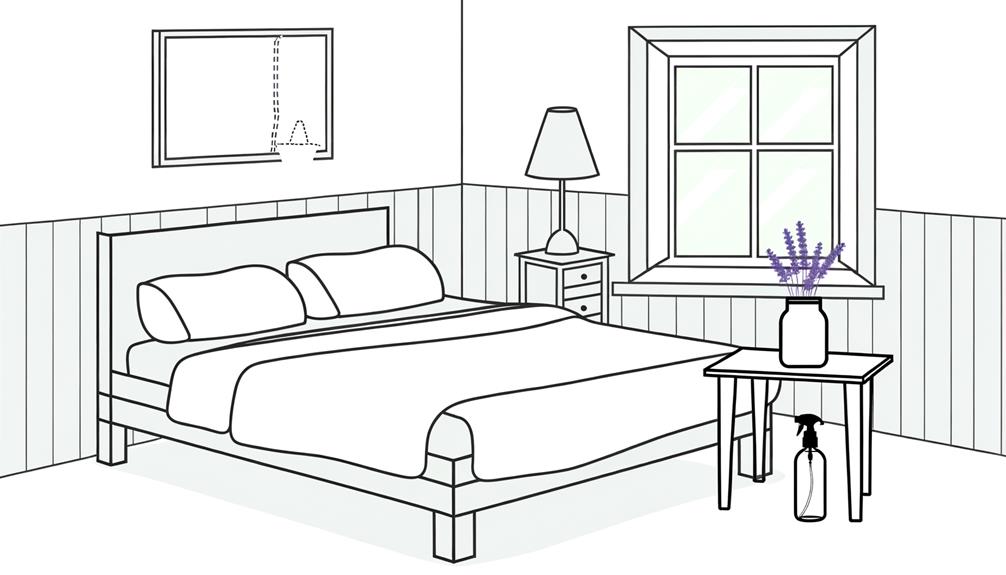
After addressing a bed bug infestation with spray treatment, it’s crucial to focus on preventing future outbreaks. You’ll need to adopt rigorous cleaning routines and regularly inspect sleeping areas to ensure the pests don’t return. Additionally, adhering to health and safety tips, such as using protective gear when applying pesticides, will safeguard your well-being during and after the treatment process.
Preventing Future Infestations
How can you ensure bed bugs don’t return, marking your home as their next target? The first crucial step is to seal cracks and crevices throughout your home. This proactive measure minimizes hiding spots for bed bugs, effectively deterring their re-infestation. Employing a professional exterminator for a thorough inspection post-treatment can also significantly bolster your defence, ensuring no stone is left unturned in safeguarding your sanctuary.
Moreover, maintaining a vigilant eye for early signs of bed bugs can prevent a full-blown infestation. Regularly inspecting bedding, furniture, and even clothing can catch these pests before they have a chance to proliferate. Remember, prevention is not just a one-time effort but a continuous commitment to protecting your space and embracing a bed bug-free lifestyle.
Health and Safety Tips
While ensuring your home remains unattractive to bed bugs is crucial, it’s equally important to consider your health and safety following any pest treatment. Post-treatment, prioritize allergy management by thoroughly cleaning your living space to remove any allergens or chemical residues. This step is vital in maintaining a healthy environment that supports your well-being. Additionally, focus on sleep hygiene by ensuring your bedroom is a sanctuary for rest. Use hypoallergenic mattress covers and regularly wash your bedding in hot water. This not only contributes to a clean sleep environment but also discourages bed bugs. Remember, a comprehensive approach combining pest control with health and safety practices fosters a sense of belonging in a secure, nurturing home.
You may also enjoy reading this article
Was This Article Helpful?
- Please provide feedback and comments to help us improve our content.
- Share your experiences and any additional tips you have for dealing with pests.
Share this Post
